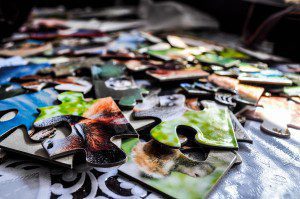 This is an activity I used in my AP Psychology classes for remembering the differences between several of the early approaches to psychology. I learned this from the Instructor Resources from Schacter, Gilbert, and Wegner’s excellent textbook, and it was adapted from Krauss, J. (1999). A jigsaw puzzle approach to learning history in introductory psychology. Teaching of Psychology, 26, 279–280.
This is an activity I used in my AP Psychology classes for remembering the differences between several of the early approaches to psychology. I learned this from the Instructor Resources from Schacter, Gilbert, and Wegner’s excellent textbook, and it was adapted from Krauss, J. (1999). A jigsaw puzzle approach to learning history in introductory psychology. Teaching of Psychology, 26, 279–280.
The basic idea here is to use a puzzle to illustrate the main ideas behind structuralism, functionalism, and gestalt psychology. In my class I would use a simple children’s puzzle, distributing one or two pieces to each student. Eventually the pieces will be put together, but the focus is on how to think about each piece a student holds.
Students begin with a structuralist approach, each attempting to describe what appears on a single puzzle piece. They aren’t allowed to see anyone else’s pieces yet, and they aren’t allowed to make any assumptions that go beyond the individual piece. They can only describe the shape of the piece, the colors present, etc. This is similar to structuralism in that Wundt, Titchener, and other structuralists attempted to identify the individual components of conscious experience. The process of describing the piece is similar to the process of introspection, in which participants attempt to describe their raw sensory experience. What should become apparent, however, is that this technique is probably not the best way to put the puzzle together. Even after hearing another student’s description of a piece, it would be very difficult to know for sure if it connected to the piece in your own hand or how the two might be related. Two students with very similar pieces might end up describing those pieces quite differently, which was also a problem with interpreting responses from introspection.
Next students try a functionalist approach, focusing on the apparent purpose for each piece. They might describe a piece as being a corner piece, an edge piece, a piece for filling in the sky, or part of a face. Just as William James emphasized understanding why a certain behavior occurred rather than focusing on the individual experience of the behavior, students consider the possible functions of a piece for completing the whole.
Next students get up from their chairs and assemble the pieces. Descriptions from the functionalist approach should help students to know which other students have related pieces so they should be able to complete the puzzle fairly quickly. Now students can use a gestalt approach, emphasizing that the whole is not the same as the sum of its parts. Seeing the entire image allows students to see possible story-lines, interpretations, and emotions that only emerge when all parts of the image are seen as a whole.
While it may seem a little childish to break out a simple puzzle with high-school or college students, I’ve found that this activity provides a great analogy for understanding these early approaches. Structuralism, functionalism, and gestalt psychology are quickly overshadowed by modern approaches in most psychology courses, so this activity can also serve as a mnemonic for recalling these perspectives when reviewing later on.
